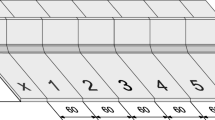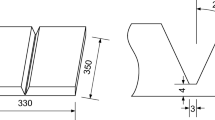Abstract
The joining by welding processes of components is usually related to the creation of additional notches and geometrical peculiarities. Multiple investigations have shown that a clear correlation between the local weld geometry and the fatigue life of welded joints exist. Thereby, the local increase of the local stress can be expressed by a stress concentration factor at the transition from the base material to the filler material, the so-called weld toe. The stress concentration factor can be determined for the most weld types if the geometric parameters such as plate thickness weld toe radius and flank angle are known. However, no standardized method for the determination of these parameters exists. Beside the well-established 2D-measurement methods on cross sections with weld impression analysis, new 3D-methods based on contactless, optical measurement were applied in the last years for the geometrical analysis of welded joints. With these methods, long length of welds can be analyzed in a very short time and with low effort. However, the influence of the measurement system (geometrical accuracy, lateral resolution) was not quantified yet. Additionally, in all known cases of application different evaluation algorithms were used. This does not allow for a straightforward comparison of the investigated parameters and results. In this round robin study, the determination of weld toe radii and flank angles by different evaluation algorithms and 3D-measurement systems and by different institutes are compared. Furthermore, an approach for the direct determination of the stress concentration factors of fillet welds by translating the complex weld shape in a 2D-finite element simulation was implemented. The results of this direct approach are compared to the stress concentration factors determined indirectly using the geometric parameters and those calculated by established approximation formulas.





















Similar content being viewed by others
Abbreviations
- SAW:
-
Submerged arc welding
- Hybrid:
-
Laser-hybrid-welding
- MAG:
-
Metal active gas
- SCF:
-
Stress concentration factor
- ρ :
-
Weld toe radius
- t 1 :
-
Base plate thickness
- θ t :
-
Flank angle
- t 2 :
-
Attachment thickness
- a :
-
Effective weld throat thickness
- s :
-
Root gap
- κ:
-
Curvature
- L :
-
Weld leg length
- ∆x :
-
Point spacing
- T :
-
Tangent vector
- K t :
-
Stress concentration factor
- N :
-
Normal vector
References
Hobbacher AF 2016, Recommendations for fatigue design of welded joints and components, 2th edition. Springer
Europeon Commitee of Standardization 2009, “Eurocode 3: design of steel structures -Part 1–9: Fatigue, 1993-1-9:2005,”
Lawrence FV (1973) Estimation of fatigue crack propagation life in butt welds. Weld J 52:213–220
Lawrence FV, Munse WH (1973) Fatigue crack propagation in butt weld containing joint penetration defects. Weld J 52:221–225
Lieurade HP, Huther I, Lefebvre F (2008) Effect of weld quality and postweld improvement techniques on the fatigue resistance of extra high strength steels. Weld World 52(7–8):106–115
Ning Nguyen T, Wahab MA (1995) A theroretical study of the effect of geometry parameters on the fatigue crack propogation life. Eng Facture Mech 51(1):1–18
Gurney TR (1979) Fatigue of welded structures. Cambridge Univercity Press, Cambridge
Maddox SJ (1991) Fatigue of welded structures. Abington Publishing, Cambridge
Barsoum Z, Jonsson B (2007) Fatigue assesment and LEFM analysis of cruciform joints fabricated with different welding processes. Weld World 52(7–8):93–105
Jonsson B, Samuelsson J, Marquis GB (2011) Development of weld quality criteria based on fatigue performance. Weld World 55(11–12):79–88
Nykänen T, Marquis GB, Björk T (2009) A simplified fatigue assessment method for high quality welded cruciform joints. Int J Fatigue 31(1):79–87
Schork B et al. 2017, “The effect of the local and global weld geometry as well as material defects on crack initiation and fatigue strength,” Eng Fract Mech.
ISO 5817:2014 2014, Welding -- fusion-welded joints in steel, nickel, titanium and their alloys (beam welding excluded) -- Quality levels for imperfections.
V. Group, STD 181-0004, Weld Quality standard
Pang HLJ (1993) Analysis of weld toe profiles and weld toe cracks. Int J Fatigue 55(1):31–36
Engesvik KM, Torgeir M (1983) Probabilistic analysis of the uncertainty in the fatigue capacity of welded joints. Eng Fract Mech 18(4):743–762
Alam MM, Barsoum Z, Jonsen P, Kaplan AFH, Häggblad HA (2010) The influence of surface geometry and topography on the fatigue cracking behaviour of laser hybrid welded eccentric fillet joints. Appl Surf Sci 256(6):1936–1945
Stenberg T, Lindgren E, and Barsoum Z 2012, “Development of an algorithm for quality inspection of welded structures,” Proc Inst Mech Eng Part B J. Eng Manuf.
Hou C-Y (2007) Fatigue analysis of welded joints with the aid of real three-dimensional weld toe geometry. Int J Fatigue 29(4):772–785
Harati E, Svensson L-E, and Karlsson L 2014, “The measurement of weld toe radius using three non-destructive techniques,” Proc 6th Int Swedish Prod Symp, pp. 1–8
Anthes R, Köttgen V, Seeger T (1993) Kerbformzahlen von Stumpfstößen und Doppel-T-Stößen. Schweißen und Schneid 45(12):685–688
Rainer G 1978, “Errechnen von Spannungen in Schweißverbindungen mit der Methode der Finiten Elemente,” Technical Univercity of Darmstadt
Berge S (1985) On the effect of plate thickness in fatigue of welds. Eng Fract Mech 21(2):423–435
Lawrence FV, Ho NJ, Munse WH (1981) Predicting the fatigue resistance of welds. Annu Rev Mater Sci 11:401–425
Le C-H 2018, “Numerische Untersuchung der Genauigkeit von Approximationsformeln für Kerbformzahlen an der realen Schweißnahtgeometrie von Quersteifen,” Institute of Technology Karlsruhe
Pang HLJ, Gray TGF (1993) Fatigue analysis of surface cracks at fillet welded toes. Faitgue Frac Engng Mater Struct 16(2):151–164
Barsoum Z, Jonsson B (2011) Influence of weld quality on the fatigue strength in seam welds. Eng Fail Anal 18(3):971–979
Lee C-H, Chang K, Jang G-C, Lee C-Y (2009) Effect of weld geometry on the fatigue life of non-load carrying fillet welded cruciform joints. Eng Fail Anal 16:849–855
Lassen T 1990, “The effect of the welding process on the fatigue crack growth,” Weld J, pp. 75–82
Engesvik KM and Lassen T, “The effect of weld geometry on the fatigue life,” in Procedings of the 3rd international OMAE conference
Remes H 2008, “Strain-based approach to fatigue strength assessment of laser-welded joints,” Helsinki Univercity of Technolgy
Tricoteaux A, Fardoun F, Degallaix S, Sauvage F (1995) Fatigue crack initiation life prediction in high strength structural steel welded joints. Faitgue Frac Engng Mater Struct 18(2):189–200
Baumgartner J 2013, “Schwingfestigkeitv on Schweißverbindungen unter Berücks icht igung von Schweißeigenspannungen und Größeneinflüssen,” Fraunhofer Verlag
Alam MM (2010) The influence of surface geometry and topography on the fatigue cracking behavior of laser hybrid welded eccentric fillet joints. Appl Surf Sci 256:1936–1945
Kirkhope KJ, Bell R, Caron L, Basu RI, Ma K-T (1999) Weld detail fatigue life improvement techniques, Part I: review. Mar Struct 12:447–474
Seshadri A 2006, “Statistical variation of weld profiles and their expected influence on fatigue strength,” Lappeenrante Univercity of Technology
Harati E (2015) Fatigue strength of welds in 800 MPa yield strength steels. Univercity West, Trollhättan
Kroon D-J 2011, “2D line curvature and normals,” Mathworks. [Online]. Available: https://www.mathworks.com/matlabcentral/fileexchange/32696-2d-line-curvature-and-normals
Al-Kaltham M 2017, “Detektion von rissauslösenden Schwachstellen an einlagigen Schweißnähten mittels berührungsloser 3D-Vermessung,” Karlsruhe Institut of Technology
Gorsitzke B, Weiß E, Rudolph J (1998) Regelwerksbasierter Ermüdungsfestigkeitsnachweiß geschweißter Druckbehälterkomponenten nach dem Kerbspannungskonzept unter Einsatz der Finiten-Elemente Methode. Tech Überwachung 30(10):33–42
Baumgartner J, Bruder T (2013) An efficient meshing approach for the calculation of notch stresses. Weld World 57(1):137–145
Author information
Authors and Affiliations
Corresponding author
Additional information
Publisher’s note
Springer Nature remains neutral with regard to jurisdictional claims in published maps and institutional affiliations.
Recommended for publication by Commission XIII - Fatigue of Welded Components and Structures
Rights and permissions
About this article
Cite this article
Schubnell, J., Jung, M., Le, C.H. et al. Influence of the optical measurement technique and evaluation approach on the determination of local weld geometry parameters for different weld types. Weld World 64, 301–316 (2020). https://doi.org/10.1007/s40194-019-00830-0
Received:
Accepted:
Published:
Issue Date:
DOI: https://doi.org/10.1007/s40194-019-00830-0




